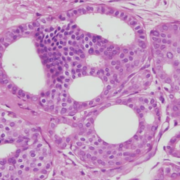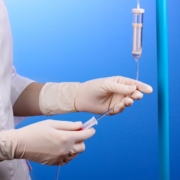16 September 2013
The following article appeared in Medscape and covered a recent study suggesting that many women base their decision to undergo a mastectomy on fear. I was happy to contribute my thoughts to what is a very complex issue and a very difficult decision for so many women. ~DJA
Fran Lowry
Sep 16, 2013
Women with breast cancer, especially younger women, are choosing to have their healthy breast removed because of mistaken beliefs about the effectiveness of mastectomy and unfounded fears about the risks for contralateral disease.
In a cross-sectional survey of 123 women with early bilateral breast cancer who chose to undergo contralateral prophylactic mastectomy (CPM), the overwhelming majority cited improving their chances of survival (94%) and reducing the risk that cancer will develop in the other breast (98%) as their primary reasons for deciding to have the additional surgery.
The results appear in the September 17 issue of the Annals of Internal Medicine (Ann Intern Med. 2013;159:428-429).
The findings highlight the need for doctors to take the time to explain the true risks and benefits of CPM, Pamela R. Portschy, MD, and Todd M. Tuttle, MD, from the University of Minnesota in Minneapolis, Minnesota, write in an accompanying editorial.
The 10-year cumulative risk for contralateral breast cancer is only 4% to 5%, the editorialists note, citing other research. In addition, “CPM is not likely to improve breast cancer survival rates.”
“The apparent discordance between patient perceptions and realistic expectations provides a teachable opportunity for physicians treating newly diagnosed patients with breast cancer,” the editorialists write, adding that the women in the study identified physicians as the most important source of information about CPM.
The study authors do not want their participants to be judged for their beliefs. “The purpose of our study was not to pass judgment on these women, because for some, for example those with BRCA mutations, it may be the right decision,” lead author Shoshana M. Rosenberg, ScD, MPH, from the Susan F. Smith Center for Women’s Cancers at the Dana-Farber Cancer Institute in Boston, told Medscape Medical News.
“Our aim was to really understand why women are deciding, in greater and greater numbers, to have this surgery,” she explained.
Nonetheless, there is more at stake for these women than just undergoing an extra surgery.
A recent study of 4200 breast cancer patients, presented at the annual meeting of the American Society of Breast Surgeons in May, found that women opting for CPM had twice as many postoperative complications as those opting for a single mastectomy.
Doctors Are Most Important Sources of Information
In their study, Dr. Rosenberg and her team surveyed 123 women from 8 academic and community hospitals in eastern Massachusetts who had early-stage cancer in 1 breast but who elected to have both of their breasts removed.
The women were part of a larger cohort study of 550 women diagnosed with early-stage breast cancer in 1 breast only from November 2006 to November 2010.
All the women were 40 years of age or younger at the time they were diagnosed; 26% had a first-degree relative and 62% had a second- or third-degree relative who had been diagnosed with breast or ovarian cancer. About one quarter of the women had a BRCA1 or BRCA2 gene mutation.
A 23-item questionnaire was administered to the women who reported having a bilateral mastectomy. They were asked how they made their decision to have bilateral mastectomy and about their knowledge, perception of risk, and breast cancer worry.
The vast majority (95%) said that the decision to remove the healthy breast gave them peace of mind.
The women also reported that doctors were their most important source of information when they were making their decision. More than half of the respondents (68 women) indicated that they were the first to bring up the issue of CPM. Half of the women reported that their physicians discussed reasons not to have the surgery.
A third of women reported that the number of surgeries or procedures needed was higher than they expected, and 42% reported that their sense of sexuality was worse than they expected after surgery. A similar percentage of women reported that they felt self-conscious about their appearance.
Removing the healthy breast might be the right decision for some women, Dr. Rosenberg emphasized. “But,” she said, “we want to make sure they are making this decision in a setting where it’s informed, and also where they are supported. Obviously, when you get a breast cancer diagnosis, it’s a very anxious time; there are a lot of worries, fears, and concerns. We think these issues should be addressed. The decision-making process needs to be supported.”
Women Not Making Well-Informed Decisions
In an interview with Medscape Medical News, Dr. Tuttle, one of the editorialists, said he is very concerned that women do not appear to be making well-informed decisions about their care.
“Many women have unrealistic expectations of what having their opposite breast removed will do,” he said.
“We did a study that was published last year in which the women we interviewed thought their average risk of getting cancer in the opposite breast over 10 years was more than 30%, when the actual risk is about 4% to 5%. The take-home message from this study, which is a great study, is that physicians need to take time and explain the facts to their patients.”
Dense Breasts a Factor?
The decision-making process for women newly diagnosed with breast cancer is extremely complex, according to Deanna J. Attai, MD, a surgeon and director of the Center for Breast Care in Burbank, California.
Physicians might wonder why so many women are choosing CPM or even mastectomy for early-stage cancer, but their patients do provide some answers, Dr. Attai told Medscape Medical News.
“There is no question that many women make their decision based on fear and an inflated sense of risk,” she said.
Dr. Attai pointed out that most of the women felt that the worry that subsequent screenings would fail to detect a contralateral breast cancer was a very important factor in making their decision, but she noted that this was not stressed by the study authors.
“Personally, I think this is a big factor. This study evaluated women under 40. There is no question that most women under 40 have relatively dense breast tissue, and there is no question that mammography is less sensitive in these women. Many younger women detect their breast cancer when it is palpable,” she said. “If your cancer was not picked up on a mammogram, you have very little faith that future mammograms would be helpful in detecting a contralateral cancer.”
Dr. Attai also said that a 40-year-old woman’s risk of developing a contralateral breast cancer could be more than 20%, assuming that she lives to age 80. But, “with chemotherapy and endocrine therapy, that risk can be less than 10%,” she added.
Dr. Attai said that breast cancer surgeons attempt to present all of the facts about surgery to their patients. “We tell them that the potential complication rate of the surgery can be as high as 50%, including the issues of unplanned operations, less than ideal cosmetic results, sexual side effects, and self-image issues,” she explained. “I also tell my patients that a 10% to 20% risk of developing a contralateral breast cancer also is an 80% to 90% chance of not developing a contralateral breast cancer.”
Dr. Attai said she is very direct with patients who come into her office initially saying they want a CPM.
“I tell them they need to hear me out while we discuss the realities of no increased survival, overestimation of risk, and so on,” she said.
One Real-World Example
Dr. Attai offered the following recent example from her practice.
“The patient is in her early 40s and her stage I breast cancer was detected on a screening mammogram. She came to me wanting bilateral mastectomy. She had seen 2 other breast surgeons and had opinions from 3 plastic surgeons,” Dr. Attai recounted. The patient was “well-informed” about the lack of survival benefit, the low risk of developing a contralateral breast cancer, and the potential complications (including self-image, sexual) of this surgery.
However, 2 of the patient’s friends had been treated for breast cancer with lumpectomy and radiation, and their experiences colored the patient’s outlook. “One was diagnosed with a contralateral breast cancer 18 months later, and then opted for bilateral mastectomy. She had horrible problems with healing on the radiated side and underwent 2 or 3 other procedures,” Dr. Attai explained. “The other friend had a lumpectomy and radiation and has a severely contracted treated breast, which is very hard and fibrotic. She has seen multiple reconstructive surgeons who have informed her of the complexity of her case and that any attempt at reconstruction is likely to result in several procedures.”
“None of these women have a family history of breast cancer or are BRCA positive. My patient told me today that she knew she made the right decision for herself, and the experience of her friends reinforced that,” Dr. Attai said.
“No matter how much we educate patients, we cannot take away their personal experiences. Because breast cancer is so common, everyone knows someone who has been treated, and there are always horror stories. I think acknowledging and discussing a patient’s personal experiences and biases is extremely important. Some of that can be overcome by education, but not all,” she added.
Dr. Rosenberg, Dr. Tuttle, and Dr. Attai have disclosed no relevant financial relationships.










Trackbacks & Pingbacks
[…] Medscape Article – Misconceptions and Fear Prompt Contralateral Mastectomy […]
Comments are closed.